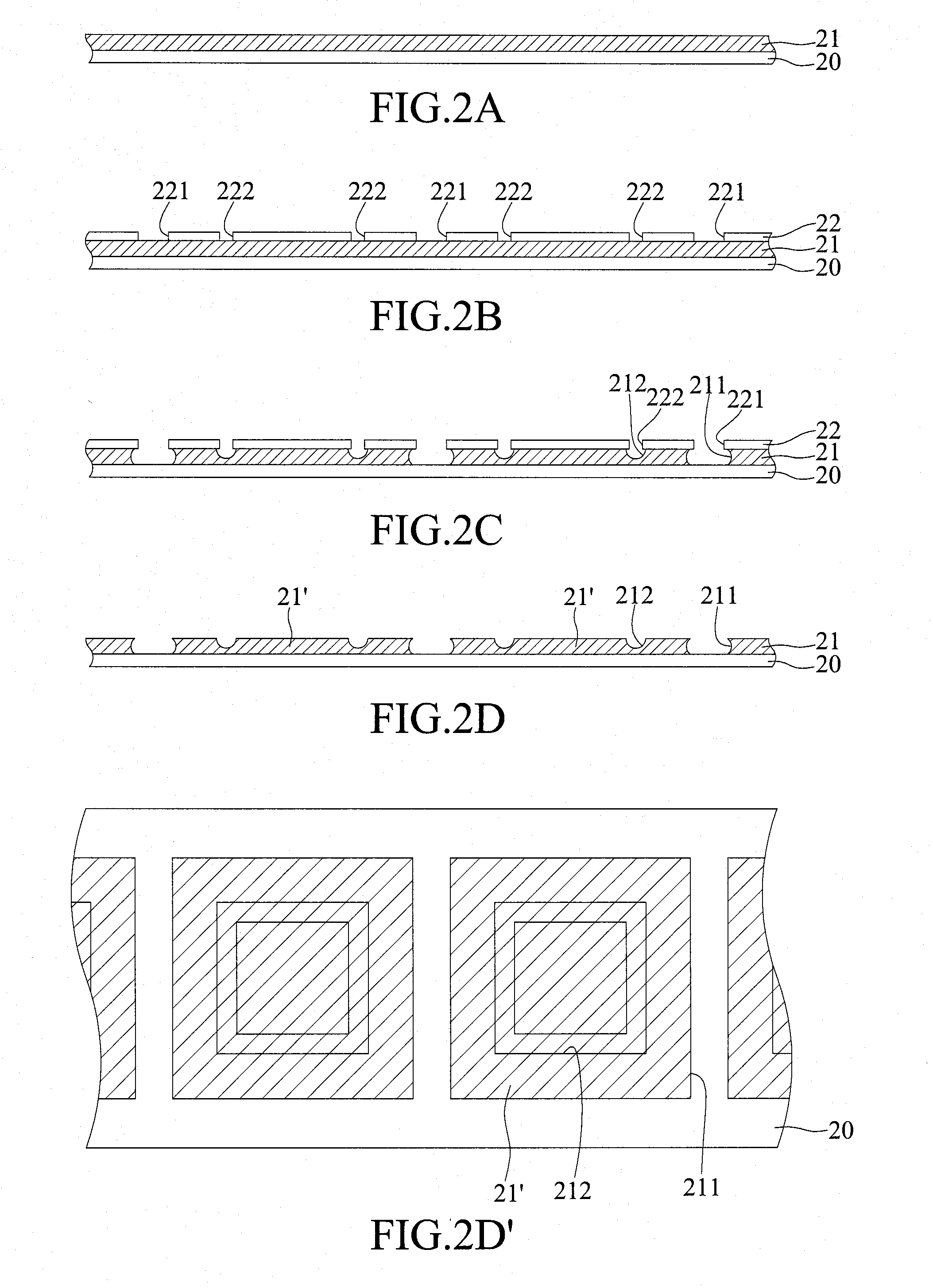Method of Manufacturing a Metallized Ceramic Substrate
- Summary
- Abstract
- Description
- Claims
- Application Information
AI Technical Summary
Benefits of technology
Problems solved by technology
Method used
Image
Examples
first embodiment
[0028]Please refer to FIGS. 2A to 2D, which are cross-sectional diagrams illustrating a method of manufacturing a metallized ceramic substrate of a first embodiment according to the present invention, wherein FIG. 2D′ is the top view of FIG. 2D.
[0029]As FIG. 2A illustrates, a ceramic substrate 20 is provided, and a metal layer 21 is formed on the ceramic substrate 20, wherein the metal layer 21 may be made of copper or aluminum.
[0030]As FIG. 2B illustrates, a resist 22 is formed on the metal layer 21, and has first patterned resist openings 221 and second patterned resist openings 222 for the metal layer 21 to be exposed therefrom. The width of the first patterned resist openings 221 is greater than 1.2 times of the thickness of the metal layer 21, and the width of the second patterned resist openings 222 is less than 1.2 times of the thickness of the metal layer 21.
[0031]As FIG. 2C illustrates, a wet-etching process is conducted. Because the wet-etching process is an isotropically ...
second embodiment
[0036]Please refer to FIGS. 3A to 3B, which are cross-sectional diagrams of a method of manufacturing a metallized ceramic substrate in a second embodiment according to the present invention.
[0037]As FIGS. 3A to 3B illustrate, subsequent to the processes performed in FIG. 2D, brushing wheels 30 brush the metal layer 21. A sand belt (not shown) may be disposed on the surface of the brushing wheels 30. A stress concentration effect may occur at a top periphery of the patterned metal layer openings 211 and the patterned metal layer dents 212 when the brushing wheels 30 are in contact with the metal layer 21. As a result, the metal layer 21 has its edge more easily brushed and removed than its surface, and the top periphery of the patterned metal layer openings 211 and the patterned metal layer dents 212 are in a curved shape, which effectively alleviating the internal stress between the metal layer 21 and the ceramic substrate 20.
[0038]In the first embodiment, the brushing wheels 30 br...
third embodiment
[0040]Please refer to FIGS. 4A and 4B, which are cross-sectional diagrams of a method of manufacturing a metallized ceramic substrate of a third embodiment according to the present invention.
[0041]As FIGS. 4A to 4B illustrate, subsequent to the processes performed in FIG. 2D, mounted points 40 brushes and removes the metal layer 21 at the top periphery of the patterned metal layer openings 211. The head 401 of the mounted points 40 may be in the conical or cylindrical shapes such that the top periphery of the patterned metal layer openings 211 are in the shape of a inclined plane or a step, which also have reduced internal stress between the metal layer 21 and the ceramic substrate 20.
[0042]In the method according to the present invention, the formation of the patterned metal layer dents is optional. Accordingly, only the patterned metal layer openings are formed by performing the wet-etching process on the ceramic substrate, and the metal layer at the top periphery of the patterned...
PUM
| Property | Measurement | Unit |
|---|---|---|
| Thickness | aaaaa | aaaaa |
| Shape | aaaaa | aaaaa |
| Stress optical coefficient | aaaaa | aaaaa |
Abstract
Description
Claims
Application Information
 Login to View More
Login to View More - R&D
- Intellectual Property
- Life Sciences
- Materials
- Tech Scout
- Unparalleled Data Quality
- Higher Quality Content
- 60% Fewer Hallucinations
Browse by: Latest US Patents, China's latest patents, Technical Efficacy Thesaurus, Application Domain, Technology Topic, Popular Technical Reports.
© 2025 PatSnap. All rights reserved.Legal|Privacy policy|Modern Slavery Act Transparency Statement|Sitemap|About US| Contact US: help@patsnap.com



